Zoom
Trash

Biodiversity hotspots in Australia and the World. Megadiverse countries Australia is one of seventeen countries described as being 'megadiverse'.
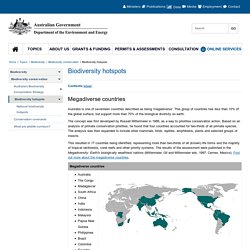
This group of countries has less than 10% of the global surface, but support more than 70% of the biological diversity on earth. The concept was first developed by Russell Mittermeier in 1988, as a way to prioritise conservation action. Based on an analysis of primate conservation priorities, he found that four countries accounted for two-thirds of all primate species. Indian Ocean-Biodiversity Hotspots. Positioned around Madagascar, the four European overseas entities of the Indian Ocean region have specific characteristics and form a very mixed area.
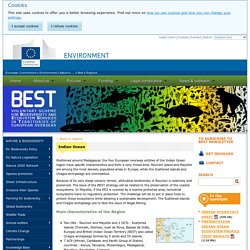
Réunion island and Mayotte are among the most densely populated areas in Europe, while the Scattered islands and Chagos archipelago are uninhabited. Because of its very steep volcanic terrain, altitudinal biodiversity in Reunion is relatively well preserved. The issue of the BEST strategy will be related to the preservation of the coastal ecosystems. In Mayotte, if the EEZ is covered by a marine protected area, terrestrial ecosystems have no regulatory protection. The challenge will be to put in place tools to protect these ecosystems while allowing a sustainable development. Main characteristics of the Region Socioeconomic, Policy and Civil Society Context (174 kB) Mayotte total population : 212,645 Reunion total population : 794,107 Scattered islands never had indigenous population nor permanent population.
Caribbean-Biodiversity Hotspot. Main characteristics of the Region The Caribbean region is mainly a chain of islands surrounded by the Caribbean Sea.
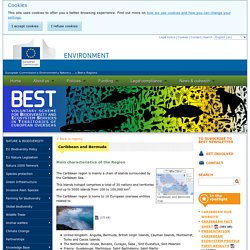
This islands hotspot comprises a total of 30 nations and territories and up to 5000 islands from 100 to 100,000 km2. The Caribbean region is home to 16 European overseas entities related to (171 kB) United Kingdom: Anguilla, Bermuda, British Virgin Islands, Cayman Islands, Montserrat, Turks and Caicos Islands The Netherlands: Aruba, Bonaire, Curaçao, Saba , Sint-Eustatius, Sint-Maarten France: Guadeloupe, Martinique, Saint Barthélemy, Saint Martin. South America-Biodiversity Hotspots. Main characteristics of the Region Located at the north of South America between Brazil and Surinam, French Guiana is the biggest terrestrial outermost territory (83 992 km2) and the smallest South-American territory. 90% of it is covered by primary tropical forest, and its 350km long coastline hosts mostly undisturbed mangroves and some sandy beaches.
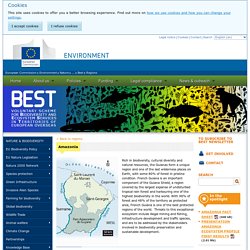
Socioeconomic, Policy and Civil Society Context French Guiana’s human population represents a true kaleidoscope of the world population, with over 40 nationalities represented. Although population density is low (2.8 inhab/km2 in 2011), population growth appears to be one of the most important in Europe (increase of 3.5% per year since the 90s): with 213 031 people in 2009, the population of French Guiana doubled in 20 years. This demographic dynamism is both an opportunity and a challenge, as economic growth (growth average of 4.3% per year between 1999 and 2007) is absorbed by population growth.
Facts and Figures Main challenges. 1214 HOTSPOT California On The Edge 1. Earth's most special places. Cerrado, the Brazilian Savanna. Located between the Amazon, Atlantic Forests and Pantanal, the Cerrado is the largest savanna region in South America.
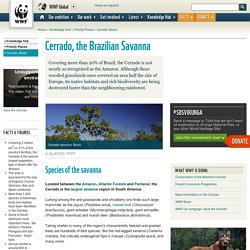
Lurking among the arid grasslands and shrubbery one finds such large mammals as the jaguar (Panthera onca), maned wolf (Chrysocyon brachyurus), giant anteater (Myrmecophaga tridactyla), giant armadillo (Priodontes maximus) and marsh deer (Blastocerus dichotomus). Taking shelter in many of the region's characteristic twisted and gnarled trees are hundreds of bird species, like the red-legged seriema (Cariama cristata), the critically endangered Spix's macaw (Cyanopsitta spixii), and many more. There are also over 10,000 species of plants, almost half of which are found nowhere else in the world. The Cerrado Biome: A Forgotten Biodiversity Hotspot · Frontiers for Young Minds.
Abstract Have you heard of the Cerrado biome?
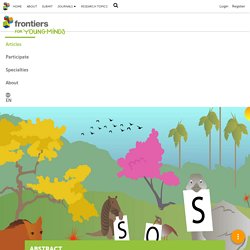
Do you know what a biodiversity hotspot is? In this article, you will learn why we should care about the biodiversity in the Cerrado biome. A biome is a community of plants and animals in a large area that shares the same climate and habitat features. Tropical biomes have the greatest diversity of plants and animals on the planet. Introduction. Australia's 15 National Biodiversity Hotspots - Biodiversity hotspots. Click on the map to read summaries of all 15 Australian National Biodiversity Hotspots. 1.
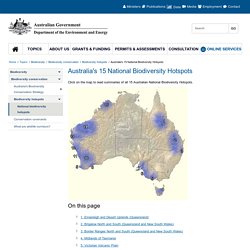
Einasleigh and Desert Uplands (Queensland) In this region of North Queensland, the high ranges and plateaus of Einasleigh contrast sharply with the plains and low ranges of the Desert Uplands. Einasleigh basalt lava flows and lava tunnels provide habitat for threatened and geographically restricted plants and animals. Water enters the Great Artesian Basin aquifers here and important artesian spring complexes contain endemic plants, snails and fish including the Edgbaston Goby and the plant Salt Pipewort (Eriocaulon carsonii). Current threats come from unsustainable grazing pressure, feral animals and in some areas tree clearing.
Top 2. The inland plains of the Brigalow belt originally supported vast vegetation communities dominated by Brigalow (Acacia harpophylla). 3. These habitats support a huge variety of bird and macropod species. 4. 5. 6. This hotspot straddles the South Australia -Victoria. Explore the Biodiversity Hotspots.